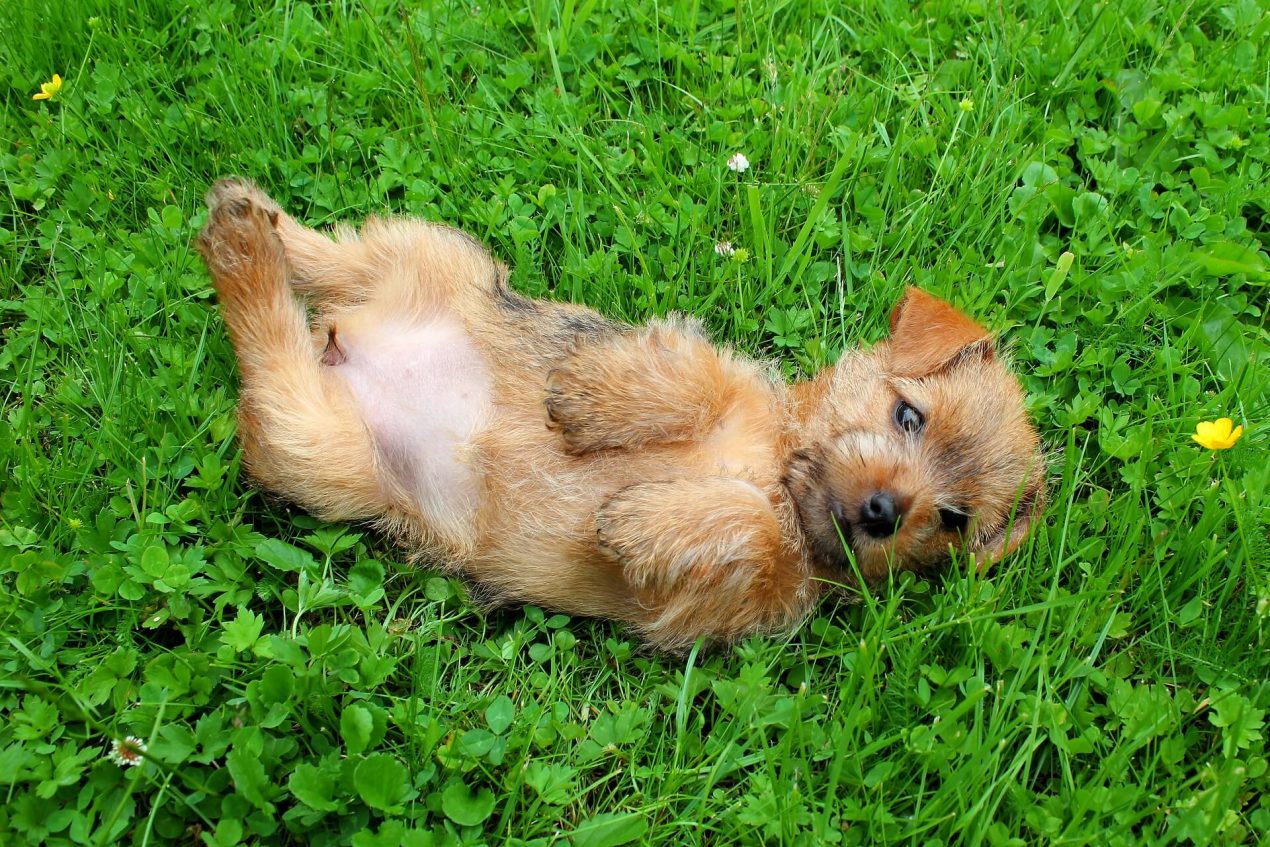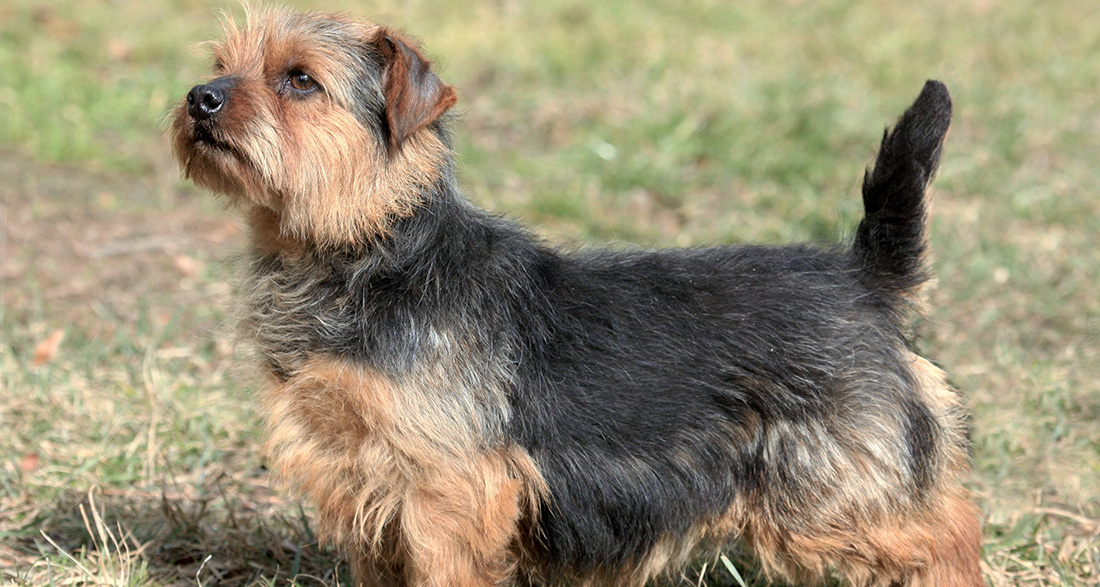The Norfolk Terrier is a very small breed of dog that exists only in small numbers. It is a friendly and cheerful animal that is very adaptable. Because the Norfolk Terrier has other great qualities as well, there are numerous interested parties, and the waiting lists are long.
History of the Norfolk Terrier
The Norfolk Terrier is closely related to the Norwich Terrier. Until the mid-20th century, they were even counted together. However, they differ in terms of their distinctive ears, which are tipped in the Norfolk Terrier and stand erect in the Norwich Terrier. Because mating standing-eared and tipped-eared parents produced unsightly offspring, it was decided to separate both types into their own breeds.
Dogs with tipped ears are now known as Norfolk Terriers, thus providing information about their place of origin (Norfolk, England). Originally, Norfolk Terriers were used in the countryside as small animal catchers. They had a reputation for being excellent hunters and more effective than cats. Due to their affable nature, their original function quickly expanded to include usefulness as family companions and companion dogs.
Breed Overview
GROUP: Terrier
HEIGHT: 9 to 10 inches
WEIGHT: 11 to 12 pounds
COAT: Short, wiry double coat
COAT COLOR: Black and tan, grizzle, red, or red wheaten
LIFE SPAN: 12 to 16 years
TEMPERAMENT: Affectionate, lively, fearless
HYPOALLERGENIC: Yes
ORIGIN: United Kingdom
Nature and Character
The Norfolk Terrier is a confident dog that would prefer to play in the top league, fearing neither risks nor dangers. However, he is not dominant or provocative. On the contrary, the Norfolk Terrier is an affectionate animal that is very friendly towards humans and other animals. Provided the dog is accustomed to human contact and has learned to interact with other dogs from an early age.
He prefers to spend time with his human cuddling, engaging in mental challenges, or engaging in physical activities. It is important that he can move and behave in a species-appropriate manner (digging and barking are firmly part of his behavioral repertoire).
| Affection Level | High |
| Friendliness | High |
| Kid-Friendly | High |
| Pet-Friendly | Medium |
| Exercise Needs | Medium |
| Playfulness | High |
| Energy Level | High |
| Trainability | Medium |
| Intelligence | High |
| Tendency to Bark | High |
| Amount of Shedding | Low |
Acquiring a Norfolk Terrier
The Norfolk Terrier is a rare dog. Up to 200 purebred offspring are documented annually in the United States. These 200 puppies are then divided among the breeders and the interested parties, so you will probably have to put yourself on a waiting list.
Unfortunately, there are hardly any alternative trustworthy sources, although there is occasionally a chance find in the animal shelter. However, the likelihood of finding a purebred Norfolk Terrier in animal welfare or a mixed breed is very low.
This means that in most cases, you will have to wait for a dog from a breeder and pay the regular price due to the rarity of the dog, which can be several thousand dollars.
What should I look out for when buying?
Before the purchase is finalized, you should have the opportunity to personally meet the puppies and see the parent animals (at least the mother).
If the breeder belongs to the Terrier Club of America, you can assume that he is reputable and has the necessary knowledge. Unfortunately, this guarantee does not exist with a private purchase. Nevertheless, your gut feeling must also be right with a reputable breeder. The relationship between buyer, seller, and dog should always harmonize.
Also, inquire whether the desired dog fits into the family in terms of character. The breeder should know his dogs so well that he can make a prognosis about the personality of the dog, taking into account that he can only report on the facets he already knows.

Development and Training of the Puppy
Because the Norfolk Terrier is a confident little fellow, he may tend to make his own decisions without guidance.
Additionally, hunting small vertebrates is in his genes (although other dogs also have hunting interest). If there are rats, guinea pigs, or rabbits within the family, you should start getting your dog used to them as a puppy. However, no matter how well the Norfolk Terrier responds to his roommates, he should never be left alone with them.
He interacts openly and socially with other dogs. However, he is not dominant or aggressive. So, the Norfolk Terrier is a beginner-friendly dog who requires typical dog training (loving but clear guidance, early socialization), but otherwise has no specific issues.
How to Keep a Norfolk Terrier
The Norfolk Terrier is very versatile and adaptable. Therefore, he fits well into various family structures. There is no population group or housing form that doesn’t suit him as long as he is integrated into social structures and gets enough physical activity.
The Norfolk Terrier feels comfortable with these lifestyles:
- An active single owner who can take him to work or on outings
- A family with children, as long as they respect the dog’s boundaries
- A senior household, provided he can get enough exercise, for example, in the garden
- A family with existing dogs or cats
The Norfolk Terrier can live in an apartment or a single-family house in the countryside. The range of different accommodation options is surprisingly large. However, because the Norfolk Terrier is very affectionate, he should never be left alone for long periods. Also, it’s important to ensure he has protection from the cold in winter. Outdoor housing alone is not recommended.
Activities with the Norfolk Terrier
The Norfolk Terrier is an alert dog who is open to a variety of activities. Whether engaging in activities with his owner or involving other dogs, he doesn’t mind as long as he gets the opportunity for long walks, play sessions, or dog sports every day.
Although he is very enduring and can meet physical demands for extended periods, just one hour of activity daily is sufficient. His need for exercise is within an adequate range, making the Norfolk Terrier a pleasant urban dweller. However, if given the choice, he would prefer an apartment with a garden. He loves being outdoors and has a real passion for digging.
Health and Care
There are no breed-specific diseases known for the Norfolk Terrier. However, being a very small dog, knee joint injuries can occur. Otherwise, the dog is robust and generally healthy.
Nevertheless,
- you should take the dog’s health care (vaccinations, parasite protection) seriously,
- check the condition of the teeth,
- keep the claws short,
- and treat the ears against mites and clean them from dirt.
For a healthy Norfolk Terrier, the standard precautions are sufficient. This also applies to its easy-care coat. You can run your fingers through the fur with spread fingers every few days or use a brush. This way, you remove the dead hairs. Additionally, you can trim the wiry coat of the Norfolk Terrier twice a year.

Interesting and Worth Knowing
Surprising traits of the Norfolk Terrier – our top 3:
- Although the Norfolk Terrier may initially seem like a lap and fashion dog, this description does not do him justice. While he is a small dog who enjoys cuddling and needs protection and warmth, he is also an active, resilient terrier who courageously stands in front of his family and barks at strangers.
- The Norfolk Terrier is a vigilant protector, a friendly family dog, an intelligent sports enthusiast, and a robust working dog. Due to his peaceable nature, he is also successfully used as a therapy dog.
- Another advantage of the Norfolk Terrier is low shedding. This makes him very popular among allergy sufferers. Important: There are no general statements about allergy-friendliness. Therefore, meet your desired dog personally beforehand to check how you react to the allergens.
Do you have a Norfolk Terrier or are you considering getting one? Tell us in the comments what you think makes him so special!


